What are the diseases of the leaves of anthurium and how to treat them?
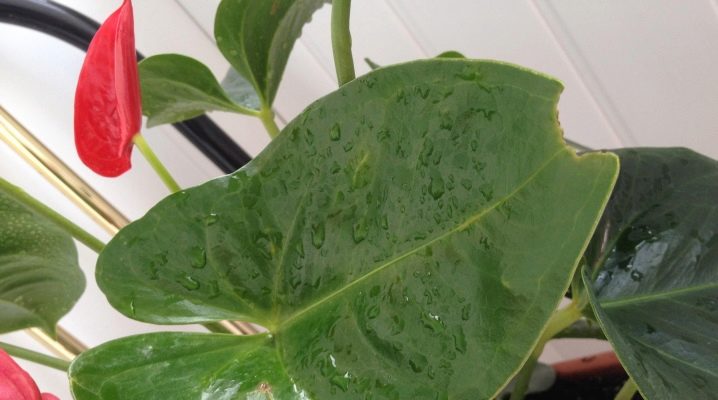
There is a list of the main diseases that plant breeders have to deal with. Most often, their appearance is a consequence of poor care, but in order to understand what the mistake is, it is necessary to dive more deeply into the topic to study.
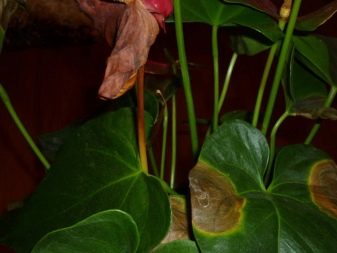
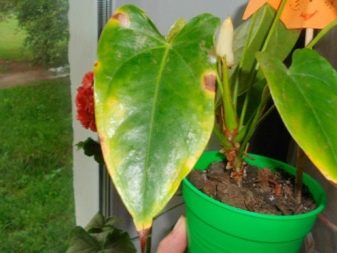
The main mistakes when leaving
It would seem that flowers should feel great at home, in fact, this is not entirely true. If the anthurium is poorly cared for, it begins to hurt, especially in winter, when the ambient temperature changes. Flower lovers should pay attention to the following, the most common mistakes:
- a sudden cold snap in a room with which the flower is unable to cope - if the anthurium is accustomed to the appropriate conditions, when the temperature drops, the leaves turn yellow and sometimes fall off, such stress leads to a decrease in the immune system, and as a result, to fungal infections; you can not put a flower near a battery or an air conditioner, you need to provide it with one level of heat at all times;
- a draft from a window or door is also often the reason why the plant begins to get sick, incomprehensible spots appear on its surface;
- not only cold, but also intense heat leads to the fact that the foliage turns black, dries, burns may appear; in this case, it is worth changing the position, perhaps removing it from the window or putting it behind a curtain;
- too much water often causes yellowing of the leaves, the subsequent formation of root and root rot;
- dry soil is the reason that anthurium has to shed foliage in order to maintain strength; in this case, the process of changing color from green to yellow can proceed very quickly, because moisture must flow regularly, especially in summer;
- in almost 100% of cases, if you move the plant to a new place, you can see yellowing of the leaves; the flower just needs time to tune in, you should not fill it with water, fertilize it additionally;
- by the way, a large amount of fertilizers is also a popular mistake not only for novice growers; in this case, the plant is re-intoxicated, burns appear in the form of not only yellowing, but also brown spots on the foliage;
- the last, but no less popular, mistake is pruning with a raw tool or the absence of subsequent treatment with a solution of activated carbon of damage through which bacteria and other pathogens penetrate.
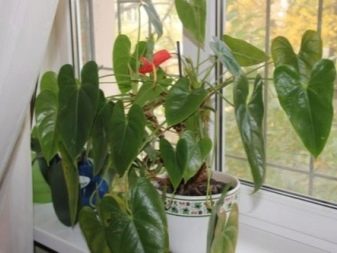
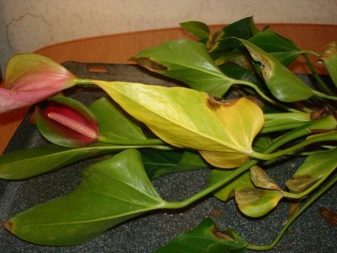
Diseases
There are many diseases that damage the leaves. To know what to fight with, you need to be able to correctly distinguish between them.
Late blight
Late blight is the number one problem, when a person does not monitor high humidity... Such a fungal disease can cause significant damage. Few people know, but late blight was one of the culprits of the Irish potato famine. This fungal disease is a serious problem for many farmers and plant breeders. Pathogens can overwinter between seasons in roots and tubers. When conditions become warm and humid, the fungus begins to multiply, usually very quickly. It also produces a huge amount of spores, which are easily airborne and infect neighboring plants.
In most cases of late late blight, symptoms begin to appear. before flowering. On older leaves, gray-green spots develop underneath. If nothing is done, they literally eat up the foliage, on which a white bloom forms underneath.
Unlike other types of fungal ailments, late blight does not hibernate on garden debris or in the soil, but is introduced through seeds, grafts, or diseased tubers.
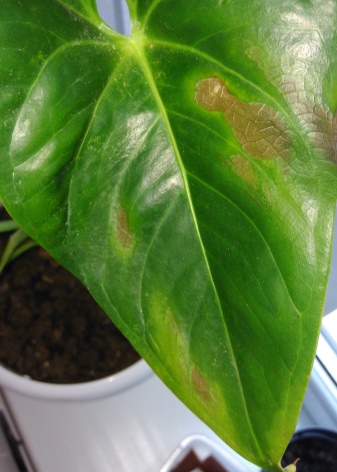

The best way to deal with late blight is use certified seeds, seedlings, do not buy diseased plants. If infected plants are found, they should be immediately treated with a fungicide, and after the growing season, the soil should be thoroughly sieved to remove roots and tubers so that the fungus cannot overwinter and reappear next year.
As a prophylaxis against the disease, it is worth providing the plant high-quality ventilation, do not overmoisten the soil.
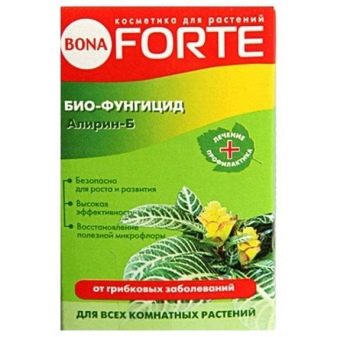
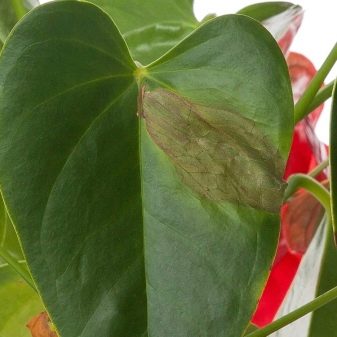
Septoriasis
This fungal disease occurs in warm, humid conditions that persist for several days. Leaf damage begins with small yellow patches that gradually turn brown. Over time, they become round with dark brown margins, blackening is observed in the center. They may or may not have a yellow halo. The disease spreads from the bottom up. The leaves turn slightly yellow, then brown, then dry up, die and fall. The stem and fruits are usually not affected.
Spores of fungi usually spread through water and air. Hyphae enter the plant through cracks and wounds in the tissue. The fungus hibernates well on decomposed plant debris and forms new spores every spring. The following measures should be taken as organic control and prevention:
- remove and destroy infected leaves as soon as they appear; check the lower and inner leaves for signs of disease;
- improve air circulation around;
- do not use overhead irrigation;
- clean tools after use.
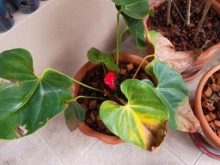
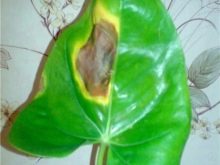
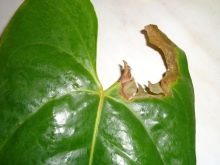
Important! Fungicides do not cure the condition, but they can help prevent it or stop its spread.
Rust
Rust disease is caused by a fungal parasite that needs living plants to survive. It is spread by spores that are carried from infected plants to healthy ones. High humidity is the main condition for the onset of the disease. To identify the problem, it is worth looking for signs such as:
- yellow or white spots that form on the top leaves of the plant;
- dry pimples or bumps form on the leaves;
- sometimes the foliage becomes red at the edges;
- reddish or orange blister bumps called pustules on the underside of leaves;
- orange or yellow spots or stripes appearing on the underside;
- leaf distortion and defoliation usually occurs.
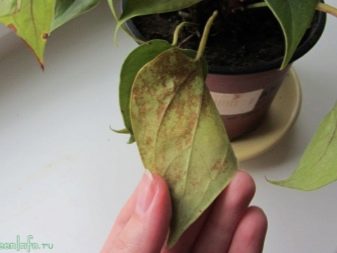

As a preventive measure, the following steps must be taken:
- remove all parts on which fungus may have formed, and destroy them;
- do not pour water on the plant;
- spray the bush with sulfur at the beginning of the season to prevent infection or keep it from spreading at the initial stage;
- position the flower correctly to ensure good air circulation.
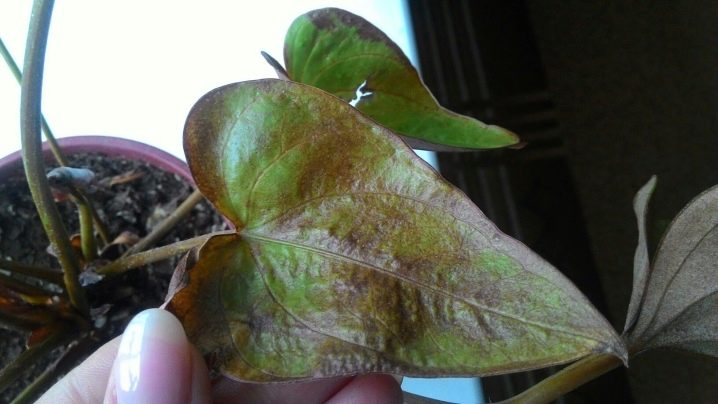
Important! Even if an infection has occurred, today there are many effective fungicides that can help cope with this problem.
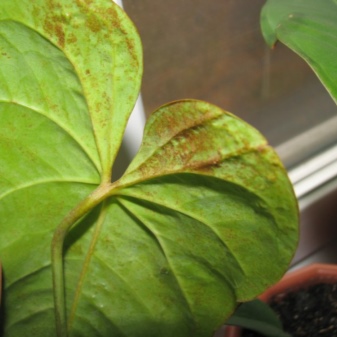
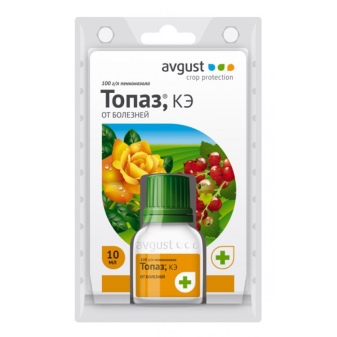
Anthracnose
Anthracnose is a disease caused by a fungal infection. Symptoms vary depending on the plant and species. Flowers, leaves and shoots are most often damaged. There are various methods to help control and prevent anthracnose. Usually, this infection spreads in warm, humid climates, usually in the spring, when the plant is actively developing. The fungus attacks growing buds and shoots, causing them to brown or blacken. If the flower is small or not very hardy, it may begin to dry out, the foliage will wither.
The infection process involves fungi such as Stegophora, Colletotrochium, Gloeosporium, Discula, and Apiognomonia. The infection is specific, which means that if it occurs on one plant, it does not necessarily mean that it will spread to other flowers. Fungi are usually incubated in soil, taking advantage of changing environmental conditions.
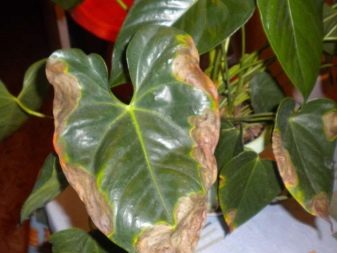
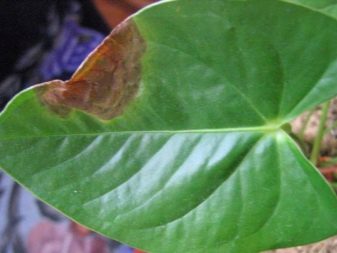
One of the best ways to prevent infection is to take care of the anthurium. If necessary, increase the amount of light and improve air circulation. Fungicides can be applied in the spring to prevent fungal growth. If the plant becomes infected, the damaged parts of the plant must be cut and destroyed.
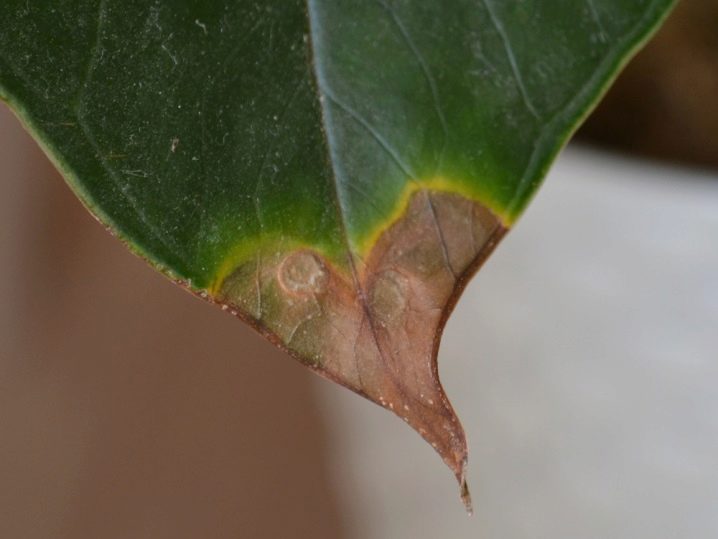
Fusarium wilt
Fusarium wilting is a widespread disease caused by many forms of soil-dwelling fungi of the genus Fusarium oxysporum. Several hundred plant species are susceptible to this problem. F. oxysporum loves soil with temperatures above + 24ºC and can live a long time without access to the plant, therefore it is not advised to take soil from the garden that is not disinfected. Affected plants are usually stunted and turn pale from green to golden yellow. The grower notices that they are drooping, dying.
Dark streaks appear on the roots and the lower part of the stem. Rotting of the root system is possible. Infected seedlings always wither and die. The spread of the pathogen can be controlled by using clean seeds and removing infected plant tissue, although planting resistant varieties is the most effective strategy. Depending on the form specialis the disease can be controlled by fungicides, although some forms have developed resistance to them.

Downy mildew
Downy mildew for "male happiness" is a biotic fungal infection that activates in cool, wet weather. It is most often recognized by yellow or discolored spots on the leaves. Not to be confused with powdery mildew, which is another common fungal infection. This infection most often appears first on older and lower leaves. If left untreated, the foliage will turn brown over time and the anthurium will die.
Initially, a plant infested with downy mildew develops brown or yellow spots. This damage expands, and the underside of the leaf will appear to be soaked in water, then holes will form. In low ambient temperatures, the disease can spread very quickly.
The main remedy is a fungicide. It is imperative to eliminate the excess moisture that feeds the infection.
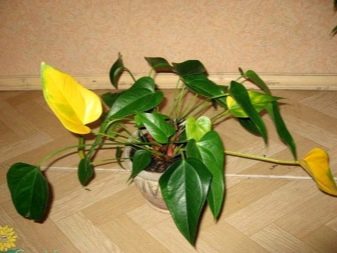

How to restore leaves?
To save the anthurium, first of all, it will be necessary to immediately improve the conditions of detention, namely, to eliminate the high humidity and increase the amount of heat in the room. It makes no sense to treat already infected leaves, they must be removed and disposed of before the infection becomes global and spreads to other bushes.
The treatment of the flower is otherwise reduced to fungicide treatment, such resuscitation will soon give a positive result. Over time, the plant, developing further under normal conditions, with proper care, it will independently build up green mass.
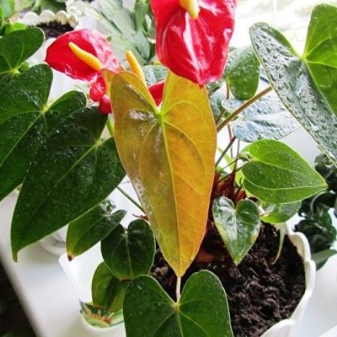
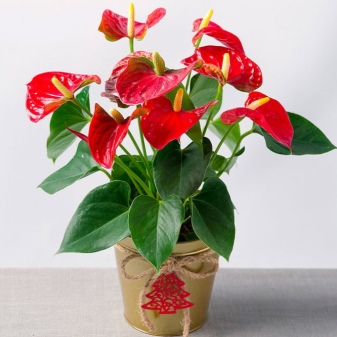
Prophylaxis
Prevention helps eliminate many future problems. It begins long before planting, with soil preparation, creation of conditions and selection of planting material. Plant diseases often provide clues to the underlying problems that have made the flower susceptible to the pathogen. This can be poor soil selection, nutrient imbalances, water stress, or improper mulching, irrigation, or pruning. If the root cause of the plant's problems can be resolved, there will be no future disease to deal with.
The disease will develop only in the presence of such three conditions as:
- the presence of a fungus;
- the flower is weakened;
- favorable conditions for the development of the disease.
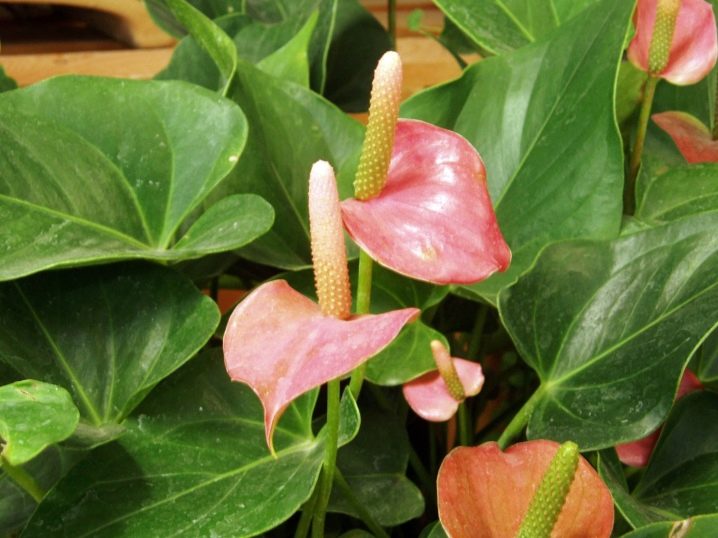
The presence of a pathogen is the first condition, therefore, it is required to cultivate the land, tools, monitor new bushes that were bought recently.
Anthurium, recently purchased in a store, is best quarantined. The likelihood of disease on a resistant plant is much less so breeding can be a key factor in managing fungal problems.
Finally, environmental conditions must be conducive to the onset of the disease. If you exclude them, then the anthurium will feel normal. For example, a sun-loving plant grown in the shade will be less vigorous and therefore more susceptible to attacks if the humidity period is extended, creating favorable conditions for disease. The best approach to prevention is to rule out any of the three conditions.
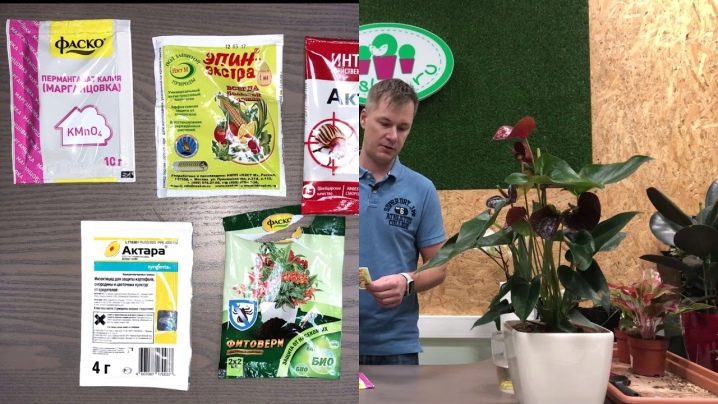
Important! It is always easier to protect a plant from a fungal infection than to fight it later, especially since many mutating species of fungi have appeared in nature.
For more information on how to cure anthurium, see the next video.































The comment was sent successfully.